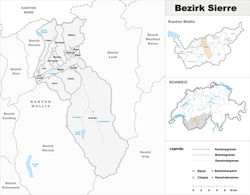Sierre (district)
|
Sierre District de Sierre |
|
|---|---|
| District | |
 |
|
| Country |
|
| Canton |
|
| Capital | Sierre |
| Area | |
| • Total | 397.0 km2 (153.3 sq mi) |
| Population (2015) | |
| • Total | 48,906 |
| • Density | 120/km2 (320/sq mi) |
| Time zone | CET (UTC+1) |
| • Summer (DST) | CEST (UTC+2) |
| Municipalities | 13 |
The district of Sierre is a district of the canton of Valais in Switzerland. It has a population of 48,906 (as of 31 December 2015).
It comprises the following municipalities
The blazon of the district coat of arms is Gules, a Sun Or.
Sierre has a population (as of December 2015[update]) of 48,906. Most of the population (as of 2000[update]) speaks French (32,090 or 80.2%) as their first language, German is the second most common (3,240 or 8.1%) and Italian is the third (1,522 or 3.8%). There are 15 people who speak Romansh.
As of 2008[update], the gender distribution of the population was 49.2% male and 50.8% female. The population was made up of 16,070 Swiss men (35.0% of the population) and 6,533 (14.2%) non-Swiss men. There were 17,331 Swiss women (37.8%) and 5,970 (13.0%) non-Swiss women. Of the population in the district 15,421 or about 38.5% were born in Sierre and lived there in 2000. There were 10,133 or 25.3% who were born in the same canton, while 4,100 or 10.2% were born somewhere else in Switzerland, and 9,037 or 22.6% were born outside of Switzerland.
As of 2000[update], there were 15,872 people who were single and never married in the district. There were 19,763 married individuals, 2,406 widows or widowers and 1,977 individuals who are divorced.
There were 5,349 households that consist of only one person and 968 households with five or more people. Out of a total of 16,811 households that answered this question, 31.8% were households made up of just one person and there were 166 adults who lived with their parents. Of the rest of the households, there are 4,312 married couples without children, 5,215 married couples with children There were 941 single parents with a child or children. There were 225 households that were made up of unrelated people and 603 households that were made up of some sort of institution or another collective housing.
...
Wikipedia
